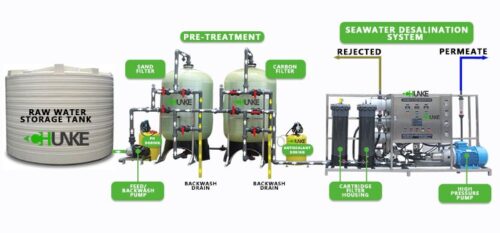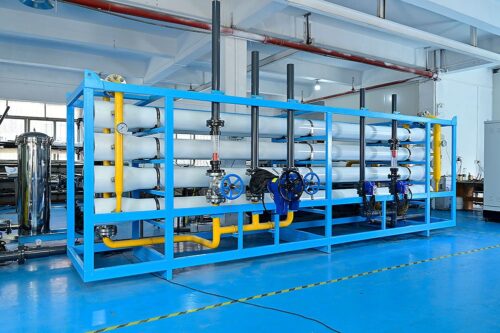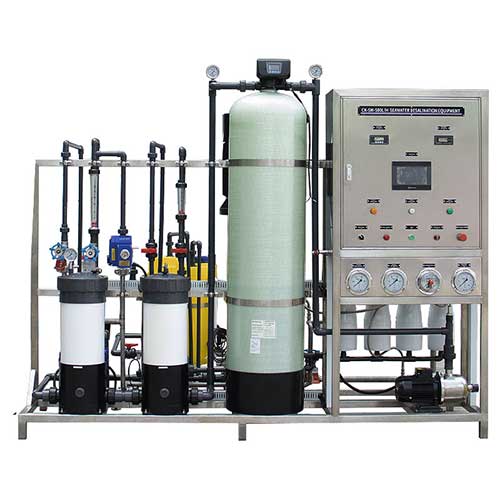Ocean water desalination plants are the removal of salt and impurities from ocean or seawater to produce fresh water. Our desalination plants use a reverse osmosis process and technology. We pump ocean or sea water into the desalination plant from the ocean and passes through pre-treatment filtration to remove most of the large and small particles.

The filtered ocean water is then forced under pressure through special SWRO membranes whereby the osmosis process that normally occurs in nature is reversed. The pores in the membranes are so small that salt, bacteria, viruses and other impurities are separated from the ocean water. In essence they act like microscopic strainers. About half of the water that enters the plant from the ocean becomes fresh drinking water. The salt and other impurities removed from the ocean water is then returned to the ocean via diffusers, which ensures it mixes quickly and prevents impacted the marine environment.
The desalinated water is then subject to further treatment to meet drinking water standards before it reaches our customers.
How Does Ocean Water Desalination Plant Work?
Desalination uses reverse osmosis technology to separate water molecules from seawater. Water from the ocean is forced through thousands of tightly-wrapped, semipermeable membranes under very high pressure. The membranes allow the smaller water molecules to pass through, leaving salt and other impurities behind.

What are the 7 Steps of Desalination?
7 Steps of Sea Water Desalination Plant Process:
- Seawater Intake System.
- Pre-treatment System.
- Seawater Desalination RO System.
- Energy Recovery System.
- Chemical Dosing System.
- CIP Cleaning System.
- PLC Controlling System.
Can We Drink Desalinated Sea Water or Ocean Water Directly?

Humans cannot drink saline water. But, saline water can be made into freshwater with SWRO Ocean Reverse Osmosis Desalination Plant, which is the purpose of this portable, inflatable solar still (it even wraps up into a tiny package). The process is called desalination, and it is being used more and more around the world to provide people with needed freshwater.
After ocean water desalination plants, you can use drink directly.
What Happens to the Salt After Desalination?
It is possible to make salt products, such as epsom salts etc, from the brine, but because the market for these products is small and the price is cheap, it is usually not economic to make products from the brine. When seawater is desalinated, the brine is returned to the sea.
To gain salt after ocean water desalination plants, you have to use evaparation and condensation process. But this investment is more and more expensive than ocean water reverse osmosis desalinaton system.

Can You Drink Ocean Water If You Boil It?
Boiling ocean water or seawater can not remove salt. So, some of your water evaparate and your ocean water becomes more salty.
Why is Desalination so Expensive?
One common desalination method, reverse osmosis, is expensive because it requires a great deal of electricity power to push water through a filter.So, SWRO Reverse Osmosis System needs big high pressure pump and because of high pressure all system needs special parts and equipments in ocean water desalination plants. It’s also costly to treat the water to kill microbes and to replace the filters. Researchers are hoping that improved membrane materials could make this process cheaper.
Which Country has the Most Desalination Plants?
Saudi Arabia leads the globe in the production of desalinated water with a daily production capacity of 117 million cubic feet. The country has 27 desalination plants spread along the country’s coastline with 21 located along the Red Sea and six located on the East Coast.
Capacity Range: 2m3 to 38m3/Day
Membrane Diameter: 2.5″-4″
Working Pressure: 700-1000psi
Feed Water TDS: 20000-40000ppm
Capacity Range: 38m3 to 2500m3/Day
Membrane Diameter: 8″
Working Pressure: 1200psi
Feed Water TDS: 20000 to 40000ppm



